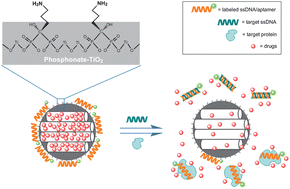
Using nanoparticles for diagnosis and drug release
A vast array of illnesses can be diagnosed by detecting specific proteins or fragments of DNA in the body. But is it possible to build a 2-in-1 system which both detects a disease and provides treatment?
Researchers at Nankai University, China, have created the first functioning system for simultaneous diagnosis and controlled drug release, a so-called “diagnospy” carrier. To demonstrate the concept, De-Ming Kong and co-workers constructed a mesoporous phosphonate-TiO2 nanoparticle scaffold loaded with ibuprofen. The amino groups on the phosphonates hold fluorescein-labelled single strands of DNA in place over the porous surface, trapping the drug molecules inside. When a complementary target strand is present, a displacement reaction uncaps the pores and the drug is released.
This mechanism relies on the highly specific affinity between complementary strands of DNA, or between proteins and their aptamers, resulting in a very sensitive detection and drug delivery system. The simultaneous sense-and-release approach is hoped to make treatments more efficient and convenient for patients in the future.
To find out more, please access the full article below. It will be free to read for the next two weeks.
Mesoporous phosphonate-TiO2 nanoparticles for simultaneous bioresponsive sensing and controlled drug release
Hui Li, Tian-Yi Ma, De-Ming Kong and Zhong-Yong Yuan
Analyst, 2013, 138, 1084-1090
DOI: 10.1039/C2AN36631B










